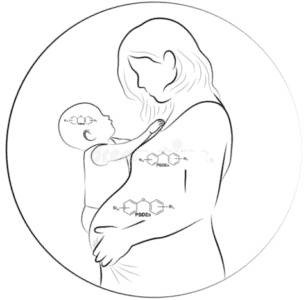Flame Retardants Linked to Autistic-Like Behavior
A class of fire-retardant chemicals, polybrominated diphenyl ethers or PBDEs, are ubiquitous–meaning they are everywhere! They are found on upholstery, carpets, curtains, electronics, and even infant products.
 Flame retardants migrate out of products into dust that humans contact and can ingest. Considered global environmental pollutants, they have been detected in water, soil, air, food products, animals, and human tissues. They are found, too, in the breast milk of women all over the world.
Flame retardants migrate out of products into dust that humans contact and can ingest. Considered global environmental pollutants, they have been detected in water, soil, air, food products, animals, and human tissues. They are found, too, in the breast milk of women all over the world.
A research team led by scientists at the University of California, Riverside, has found that when female mice exposed to PBDEs pass on these neuroendocrine-disrupting chemicals to their developing offspring, the female offspring show traits relevant to autism spectrum disorders, or ASD. Their short-term social-recognition ability and long-term social memory are reduced significantly. The offspring show exaggerated “marble burying” behavior — repetitive behavior reminiscent of human compulsive behavior, a core symptom of ASD.
“Our data support a link between maternal toxicant exposures and abnormal social and repetitive behavior in mice offspring that is relevant to ASD,” said Margarita Curras-Collazo, a professor of neuroscience, who led the study published in the journal Archives of Toxicology.
The research team also found that the female offspring’s olfactory — or smell — discrimination of social odors is significantly compromised.
“Humans mostly rely on faces to recognize people and most autistics show deficits in face-identity processing,” Curras-Collazo explained. “Mice, on the other hand, rely on smell for social recognition. The female offspring of mother mice exposed to PBDEs showed olfactory deficits that dampened their ability to recognize other mice. In effect, these offspring do not distinguish new mice from familiar ones. Humans with ASD also show abnormal olfactory ability.”
To the authors’ knowledge, their study is the first to show autistic-relevant behavior and brain changes in female offspring from maternal transfer of environmental pollutants….“This indicates that PBDEs are particularly detrimental if exposure occurs during development and effects are long-lasting, which is concerning given that children are disproportionately exposed to PBDEs,” Kozlova said.
Next, the researchers examined the brains of the offspring, specifically, gene expression for oxytocin, a neuropeptide involved in social recognition memory. They found that oxytocin and other pro-social genes had undergone changes, suggesting that PBDEs target distinct brain systems to promote neurodevelopmental abnormalities.
While most biomedical research is done using rodents, these studies have implications for humans. Like humans, mice live in social groups and communicate dominance and subordinate behavior while competing for access to resources. A mouse’s ability to recognize others is a key behavior with translational relevance to human social cognition.
“Consumers need to be aware they are being exposed to chemicals like PBDEs,” Curras-Collazo said.
“You cannot easily avoid these chemicals since they are added to many indoor products in the home, school, car, and airplane. To avoid them you can buy PBDE-free furniture or cover the foam in your furniture, choose less contaminated foods, and vacuum and mop frequently to remove PBDE-contaminated dust. It’s crucial we understand these chemicals are present in our bodies and what they are doing.”
Read the full press release here



